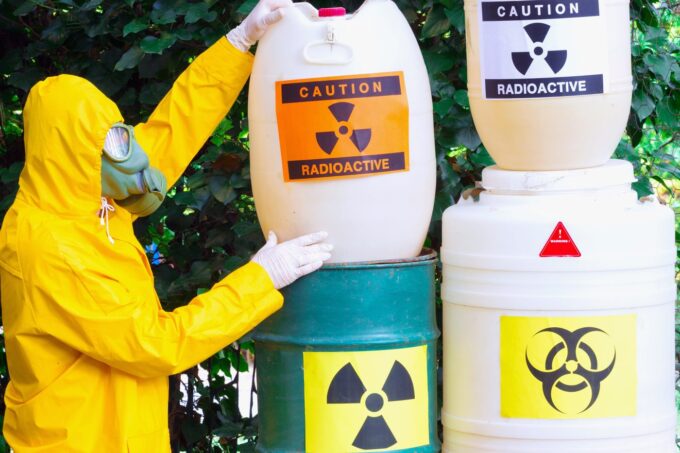The new Suva checklist "Electroplating technology
The legally compliant and safe storage of hazardous substances is a complex issue. It is necessary to separate substances from one another that may react with one another in a hazardous manner, require different protective measures or extinguishing agents, or are otherwise incompatible. Storage separation aids are therefore indispensable.

With large article assortments, with hundreds or even thousands of articles, a clean, substance-by-substance assessment becomes very time-consuming. Aids and systems to simplify stock classification are therefore indispensable in the development of warehouse concepts. Such aids cannot be perfect - chemistry is too versatile - but they greatly speed up the organization of a hazardous materials warehouse. An established system for grouping hazardous substances for storage in Switzerland is the storage classes according to the cantonal guidelines. Closely related are the separation rules according to the VKF fire protection guideline 26-15 "Hazardous substances". A new tool is described in the Suva checklist 67201 "Electroplating", which was published in December 2020. Included in this checklist is the "Chemical Compatibility" table - a 9×9 matrix that contrasts the 9 GHS pictograms and specifies whether co-storage of products with each pictogram is possible, prohibited, or possible with additional safety measures. The system is impressively simple. With the GHS pictograms as a basis, it can be applied directly in the warehouse - a glance at the hazardous substance labels is enough. But how meaningful are GHS pictograms as a criterion for mixed storage and how suitable are the mixed storage rules?
One thing is clear: The pictograms according to GHS were not defined as compatibility classes, but they identify different types of physical hazards, health hazards and environmental hazards. If these criteria are compared with each other in order to derive storage regulations, inconsistencies inevitably arise. This is most clearly illustrated by the "flame" pictogram GHS02. It identifies highly flammable substances of all aggregate states (gaseous, liquid, solid) as well as substances capable of self-heating and self-ignition, organic peroxides and substances that form flammable gases on contact with water. Expressed in storage classes (LK) according to cantonal guidelines: LK 3, LK 4.1, LK 4.2, LK 4.3, part of LK 5 as well as part of LK 2. From 100 kg storage quantity, products of these storage classes are generally to be stored in separate fire compartments.

If we look at the other pictograms, the selected criteria according to the Suva checklist cover at least most of the classic incompatibilities in the field of electroplating: strong acids and alkalis, cyanide salts, flammable liquids and strong oxidizing agents. Here, the table therefore allows a useful initial assessment.
A possible advantage of the table according to Suva compared to the storage classes: A product can have multiple hazardous properties and be labeled with multiple GHS pictograms, all of which can be taken into account when assigning storage. This is in contrast to the storage class system, in which each product is assigned to a single storage class based on a prioritization of hazard properties. For example, highly flammable liquids that are also highly acidic or basic would be assigned to the same storage class, LK3 - the separation of acidic and basic products can then easily be forgotten. Based on the GHS pictograms, the corrosive effect of the products would be recognized on the basis of GHS05 - storage together is only permitted under certain conditions.
At the same time, contradictions arise very quickly from this consideration. Consider, for example, the storage together of the simple alcohols ethanol and methanol. Both belong to storage class 3, highly flammable liquids. In addition, ethanol is labeled as an eye irritant (GHS07 exclamation mark). Methanol is toxic and harmful to organs (GHS06 & GHS08): once flame and exclamation mark - once flame, skull and crossbones and harmful to health. From a chemical point of view, there is nothing to be said against storing them together; the two alcohols do not react with each other in a dangerous way. The alcohols are also comparable in terms of fire behavior. According to the Suva checklist, however, GHS 02 "Flame" and GHS06 "Skull and crossbones" cannot be stored together - so that the combined storage of methanol and ethanol would not be permitted. This is a clear contradiction to the storage class classification and makes little sense from a chemical point of view.
Other anomalies
According to the Suva checklist, storage of explosive substances (GHS01, exploding bomb) together with substances with the GHS exclamation mark is permitted. The storage guide of the cantons classifies explosive substances in storage class 1 and does not treat them further - storage together with other storage classes is not foreseen.
For compressed gases (GHS04, gas cylinder pictogram), the Suva checklist also indicates incompatibilities that are not clearly comprehensible - for example, the co-storage of gas cylinders with corrosive substances (GHS05) and with oxidizing agents (GHS03) is permitted under certain conditions - but co-storage with irritant (GHS07) or environmentally hazardous (GHS09) substances is excluded. The storage guide requires separate storage for gases weighing 100 kg or more - preferably in free-standing buildings without basements or in mesh crates.
Conclusion
The compatibility table in the new Suva checklist "Electroplating" should be used with caution. At best, it can serve as a rough guide for an initial assessment and it covers the most common incompatibilities that arise in electroplating. However, the table cannot replace the storage guide of the cantons to develop a hazardous material storage concept. And: With both systems for assessing the storage of hazardous substances together, a look at the safety data sheets remains necessary in the end. Product-specific incompatibilities according to chapter 10 and storage regulations according to chapter 7 of the safety data sheet must always be additionally observed.
Useful links:
Electroplating checklist from Suva: suva.ch/67201.d
Camp Guide: kvu.ch/en/working-groups?id=151
VKF fire protection regulations: bsvonline.ch/en/regulations









